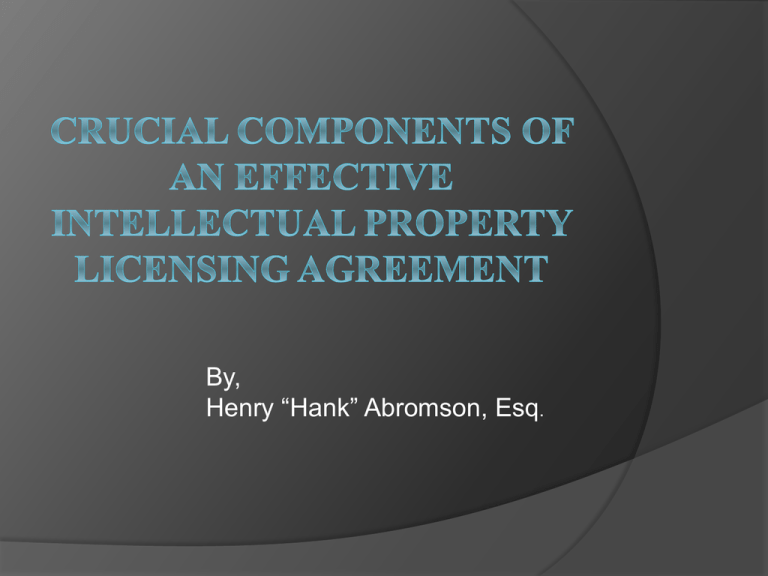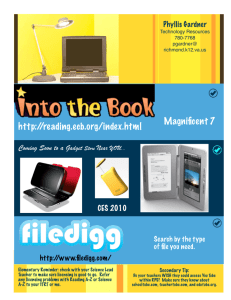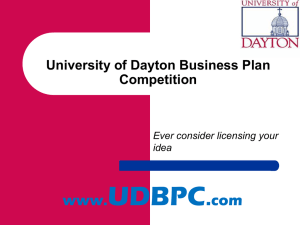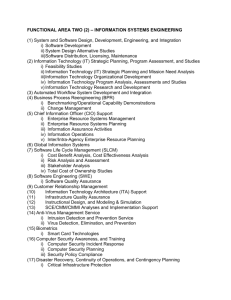Crucial Components of An Effective Intellectual Property Licensing
advertisement

By, Henry “Hank” Abromson, Esq. Introduction Henry “Hank” Abromson Attorney with Miles & Stockbridge P.C. (Frederick) Intellectual Property, Corporate, Commercial Transactions, Cyber/Computer Law Transferring Intellectual Property License v. Assignment Assignment Selling the farm, all of your right, title and interest in and to the property Flat rate payment Not typically concerned with what happens to the rights or with a return of the rights; Can have a reverter. Transferring Intellectual Licensing Typically maintaining your rights in and to the original, protected work Lending or leasing a third party to use or exploit one or more of your rights in the bundle of rights Typically concerned about recovery of rights, protection and use of the rights, maintenance of the rights, and protections if the third party damages or harms you or your rights through such use. Licensing your rights is like letting your friend borrow your favorite toy for a fee. Transferring Intellectual Property Licensing can be a valuable tool Possess a protectible invention, work or mark that you don’t want to take the time, effort or expense to exploit but want to monetize it (trademark apparel, software development, patented invention) Licensing can be the core of your business model, with royalty income as your leading driver of revenue Licensing Terms License Grant Don’t get lazy, be specific and clear What types of IP are being licensed Is this an exclusive or non-exclusive license Define the territory exp. U.S., Worldwide Revocable or non-revocable On-going royalties or “paid-up” Transferrable or non-transferrable Sublicenseable or not sublicenseable Perpetual or limited term Licensing Terms Be Aware of What You are Licensing Be specific to mention the rights Each type of IP has its own unique bundle of rights Copyright – use, reproduce, display, perform, make derivative works, sell etc. Patent - exclude others from making, using, offering for sale, selling, or importing into the United States the invention claimed in the patent Trademark – Use Licensing Terms Exclusive or Non-Exclusive Can you license to others or just to this licensee The more exclusivity, the greater the royalty rate because the less opportunity you have to drive in revenue from other licensing sources Licensing Terms Territory Depending on what type of IP is involved, the product or the market, will likely determine the territory Sometimes cost prohibitive to take the license internationally, sometimes it might risk the rights, sometimes it makes sense The broader the territory, typically the greater the royalty rate Licensing Terms Term How long do you want the license to be in effect? ○ Short term, long term, short term with automatic renewable terms ○ Renewals can be based on revenues ○ I prefer to not have client be locked into long term agreements because you never know what the future will hold, but it can make sense Licensing Terms Negotiating Royalty Rates No hard and fast rate; dependent on many variables There are books that list common rates, but it really depends on the situation Typical variables: ○ Uniqueness of product, competition ○ Value of the IP on the market (think valuable trademark and ○ ○ ○ ○ ○ ○ ○ ○ ○ franchising) Common rate in the marketplace Effort and expense into the R&D How long is the term Exclusivity Territory Remaining life Are the rights protected through registration, are they strong Based on gross or net revenue Sublicensable Licensing Terms How and when will you be paid Flat rate up front Ongoing royalties Both an upfront payment and ongoing royalties Quarterly, Annually, Installments, Lump Sum Licensing Terms Key Protections Indemnification – Reimbursement of costs if the licensee gets you sued or harms you as a result of its actions or inactions Audit Rights – Financial (books and records) and Quality Assurance (no harm to your brand through bad products or misused IP) Representations & Warranties – Authority, no infringement, solvent, no legal claims against, no prohibitions from entering agreement Governing Law, Jurisdiction and Venue – Ensure home field advantage Termination Provisions - What rights do you have to terminate, what rights do they have. Questions Henry “Hank” Abromson Miles & Stockbridge P.C. Tele: (301) 698-2325 Email: habromson@milesstockbridge.com THANK YOU!







